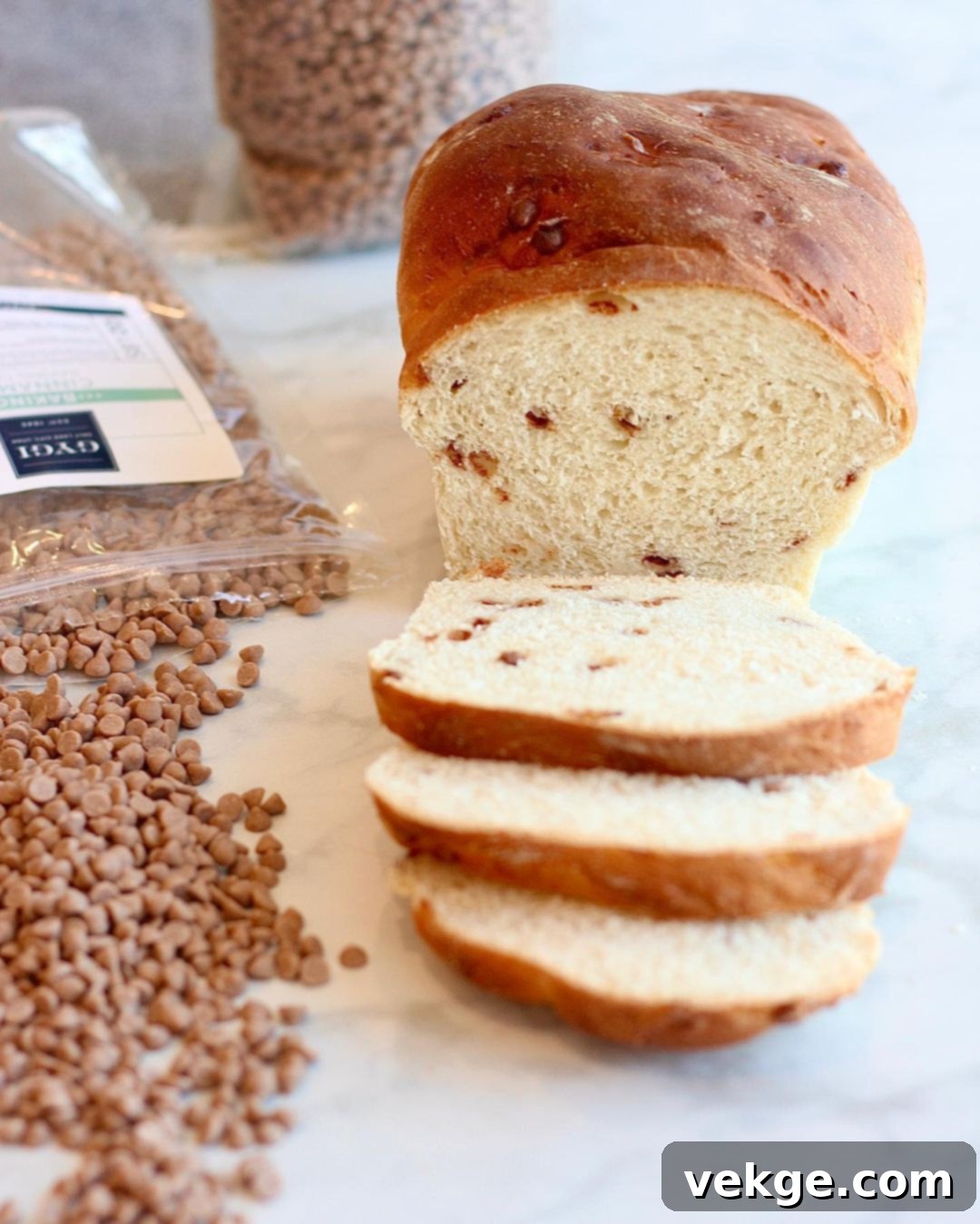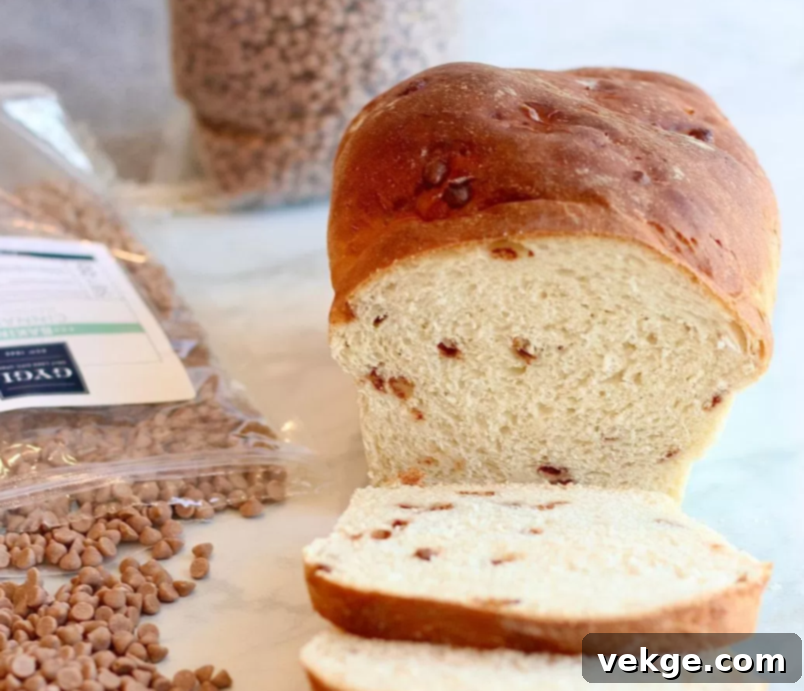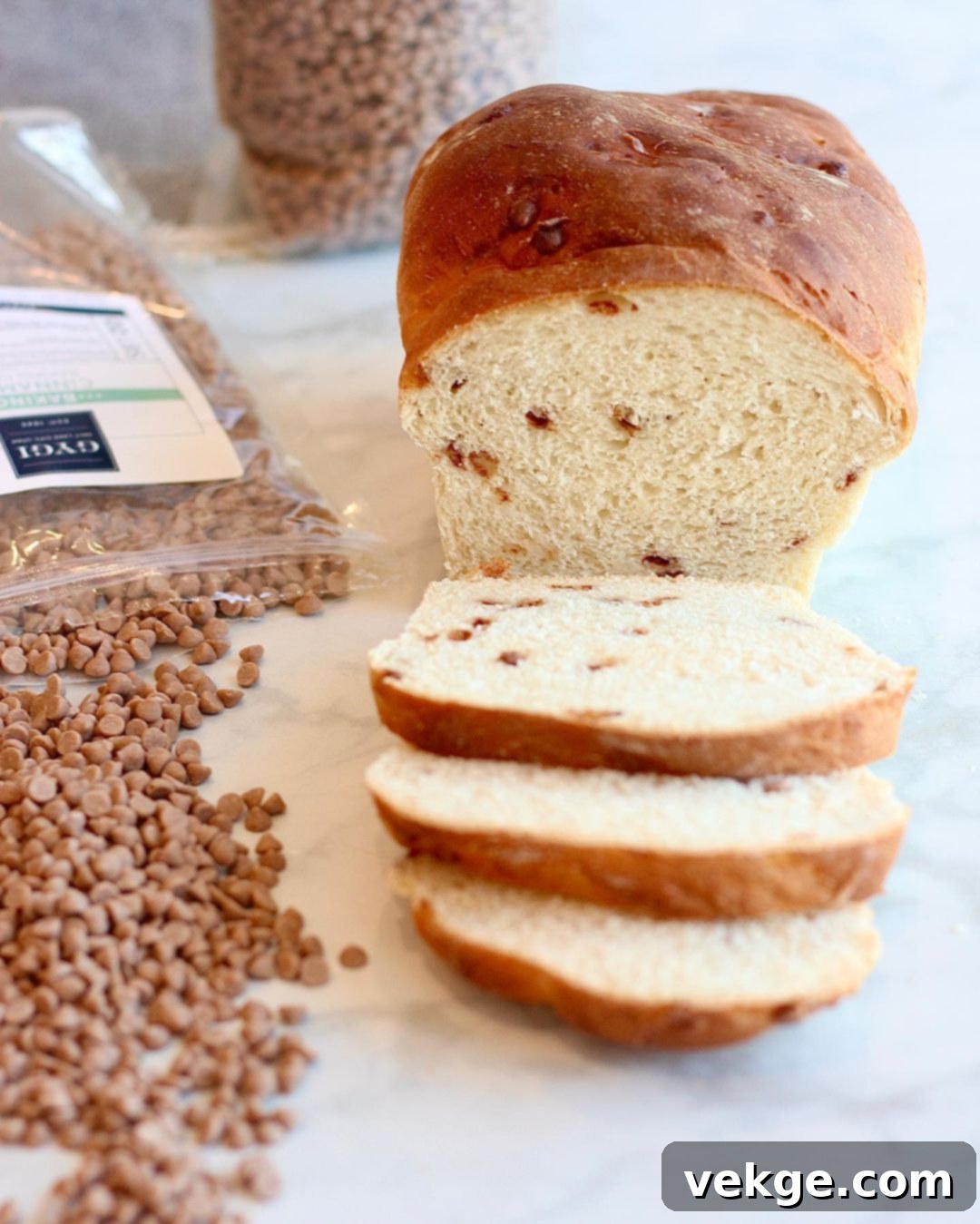The Ultimate Homemade Cinnamon White Bread: A Divine Delight for Breakfast and Beyond
Imagine waking up to the irresistible aroma of freshly baked bread, warm and comforting, with delightful pockets of sweet, spicy cinnamon chips. This isn’t just any white bread; it’s a culinary revelation that will undoubtedly transform your breakfast table. My special recipe for cinnamon white bread is meticulously crafted to be incredibly fluffy, utterly mouth-watering, and undeniably divine. And here’s a little secret for you: it makes the absolute best cinnamon chip French toast you’ll ever taste, turning a simple breakfast into an extraordinary experience!
Baking homemade bread might seem like a daunting task, reserved only for seasoned culinary experts, but I promise you, with this straightforward recipe, it’s an incredibly enjoyable and profoundly rewarding experience. There’s nothing quite like the immense satisfaction of pulling a golden-brown, perfectly risen loaf from your own oven, knowing that you created something truly special and wholesome from scratch. This cinnamon white bread isn’t just food; it’s a comforting hug in every slice, ideal for cozy morning meals, satisfying afternoon snacks, or sharing with cherished loved ones during any occasion. Get ready to impress yourself and everyone around you with this spectacular bake.

Choosing the Right Cinnamon Chips for a Perfect Bake
The secret to this bread’s incredible texture, consistent flavor, and delightful visual appeal lies not only in the perfectly prepared dough but also, crucially, in the quality and type of cinnamon chips you select. Not all cinnamon chips are created equal, especially when it comes to standing up to the rigorous demands of baking. Some brands tend to melt away or completely lose their distinct shape during the prolonged rising stages and the high heat of oven baking, leaving you with cinnamon-flavored streaks rather than the delightful, intact pockets of spice we all crave.
After extensive experimentation and many delicious trials, I wholeheartedly recommend the high-quality cinnamon chips from @orsongygi. These specific chips are, without exaggeration, a true game-changer in the world of baking! They are specially formulated to hold their shape beautifully and consistently through both the crucial rising stages and the intense heat of baking. This meticulous formulation ensures that every single slice of your cinnamon white bread will boast distinct, delicious morsels of cinnamon that provide a burst of aromatic flavor and a lovely textural contrast, making each bite an absolute joy. What’s even better is that Orson Gygi ships their products, making these superior chips accessible to bakers no matter where you are located!
While nationally recognized brands like Hershey’s cinnamon chips are undeniably delicious and conveniently readily available in most grocery stores, I’ve consistently found that they tend to soften significantly and often lose their distinct chip shape when thoroughly incorporated into the bread dough and then subjected to baking. If, for any reason, Orson Gygi chips are not a viable option for you, Hershey’s can certainly still be used as a tasty alternative. However, it’s important to be aware that the final appearance of the cinnamon “chips” within your bread might be more dispersed and less defined. Whichever brand you ultimately choose, the overarching key to maximizing the rich cinnamon flavor and delightful texture in your homemade bread is to ensure that your chips are fresh and of the highest possible quality.

Why Homemade Cinnamon White Bread is an Absolute Must-Try
Beyond the sheer joy and therapeutic nature of baking, there are truly countless compelling reasons why this extraordinary cinnamon white bread recipe deserves a permanent and cherished spot in your kitchen repertoire. It’s more than just a recipe; it’s an experience:
- Unmatched Flavor Profile: The harmonious combination of a soft, delicately sweet white bread base with the warm, aromatic spice of cinnamon is simply irresistible. It takes a classic comfort food and elevates it to new, gourmet heights, making every bite a memorable one.
- Perfectly Balanced Texture: This specific recipe consistently yields an incredibly fluffy, tender, and light crumb that is never dry or dense. It’s precisely the kind of bread that virtually melts in your mouth, offering a delightful chewiness that’s characteristic of expertly baked goods.
- Remarkable Versatility: While this bread truly shines as an outstanding standalone treat, perfect for a quick snack, its versatility truly comes to life when you consider its potential for spectacular breakfasts and desserts. Imagine gourmet French toast, a rich and comforting bread pudding, or even simply toasted and topped with a dollop of cream cheese or fruit preserves.
- An Aromatic Experience: The heavenly scent that permeates and fills your entire home as this bread bakes is nothing short of pure bliss. It acts as a natural, inviting air freshener that instantly transforms your kitchen into a warm, cozy, and welcoming sanctuary, enticing everyone with its delightful perfume.
- Easily Customizable: This recipe offers wonderful flexibility! Feel completely free to adjust the amount of sugar or honey to precisely match your personal preference for sweetness. You can also experiment with adding a delicate dash of nutmeg, a pinch of cardamom, or even a hint of vanilla extract for an extra, complex layer of aromatic flavor, making it uniquely yours.
Recipe: Fluffy Cinnamon White Bread

Cinnamon White Bread
Print
Pin
Rate
Breads
25 minutes
25 minutes
1 hour 30 minutes
2 hours 20 minutes
3 large loaves
Ingredients
- 3/4 cup sugar or honey
- 3 cups warm water
- 1 1/2 T active dry yeast
- 1/3 cup coconut oil melted
- 1 egg
- 1 T salt
- 8 to 8 1/2 cups bread flour
- 1 cup cinnamon chips
Instructions
- 1. Activate the Yeast (Proofing): In a generously sized mixing bowl (I wholeheartedly recommend using a robust stand mixer, such as a Bosch Mixer, for optimal results with this recipe), combine the measured sugar or honey with the warm water. It’s absolutely crucial to ensure the water temperature falls precisely between 105-115°F (40-46°C) – water that is too hot will unfortunately kill the delicate yeast, rendering it inactive, while water that is too cold will fail to properly activate it. Gently sprinkle the active dry yeast evenly over the surface of the water and sugar mixture. Allow this concoction to stand undisturbed for a full 10 minutes. During this vital period, the yeast will “proof” by becoming distinctly foamy and bubbly, which is your clear indication that it is active, vibrant, and perfectly ready to work its magic in your dough. This critical step is the foundation for achieving beautifully light, airy, and flavorful bread.
2. Incorporate Wet Ingredients: Once you’ve confirmed that the yeast is vigorously active and bubbly, proceed to add the melted coconut oil, the whisked egg, and the salt to your yeast mixture in the bowl. Mix all these components thoroughly, either with a spoon, spatula, or on low speed with your stand mixer, until they are seamlessly combined and integrated. The addition of the oil is vital for contributing to the bread’s tenderness, while the egg enriches the dough, further enhancing that truly irresistible, fluffy texture we’re aiming for.
3. Add Flour and Knead Thoroughly: Begin the process of adding the bread flour, one cup at a time, ensuring you mix well after each individual addition. Bread flour is specifically preferred for this recipe due to its inherently higher protein content, which is essential for developing gluten more effectively. This gluten development, in turn, results in a chewier, more structured, and satisfying bread. Continue to add flour cautiously until the dough achieves a consistency that is pleasantly tacky but no longer overtly sticky to the touch. You’ll know it’s just right when the dough begins to visibly pull away cleanly from the sides of the mixing bowl. It’s incredibly important to resist the urge to add an excessive amount of flour, as this common mistake will inevitably lead to a dry, dense, and less enjoyable loaf. Knead the dough vigorously for approximately 5 minutes if doing so by hand, or for 2-3 minutes in a stand mixer. Proper and thorough kneading is absolutely essential for fully developing the intricate gluten structure that gives homemade bread its characteristic, desirable texture and rise.
4. First Rise (Bulk Fermentation): Lightly grease your large mixing bowl with a touch of oil, then carefully place the prepared dough inside. Turn the dough once to ensure it’s evenly coated with the oil. Next, cover the bowl securely with a clean kitchen towel or a piece of plastic wrap. Allow the dough to rise undisturbed in a warm, draft-free location until it has visibly doubled in size. This crucial first rise, often referred to as bulk fermentation, typically takes approximately 45-60 minutes, though the exact time can vary depending on the ambient warmth of your kitchen environment. This stage is fundamental for building both flavor and structural strength within the dough.
5. Second Rise (Punch Down and Rest): Once the dough has proudly doubled in size from its first rise, gently but firmly “punch down” the risen dough. This action serves to release the accumulated air and redistribute the yeast, sugars, and enzymes evenly throughout the dough, which significantly helps in creating a finer, more consistent crumb in the final bread. Cover the dough once more and allow it to rise for a second time, for roughly 30-45 minutes, or until it has nearly doubled in size again. If you are pressed for time and prefer a slightly faster baking process, you technically can skip this second rise, particularly if you’ve performed a very thorough 15-minute initial knead. However, for the absolute best flavor development and an exceptionally tender texture, undertaking both rises is highly recommended.
6. Add Cinnamon Chips and Shape Loaves: After the completion of the second rise, gently knead the dough again for about 5 minutes by hand or 2-3 minutes in your mixer. Now comes the exciting part – it’s time to introduce the star ingredient! Add the pre-selected cinnamon chips and gently mix them into the dough until they are thoroughly and evenly incorporated. Exercise caution here to avoid overmixing, as this can unfortunately crush the delicate chips. For baking standard 4.5×8.5 inch loaves, carefully separate the dough into 3 perfectly equal sections. If you desire charming mini loaves, then divide each of those three larger sections into three smaller portions again, resulting in a total of 9 individual mini loaves. Form each section into a rough rectangular shape. With each rectangular section, roll it tightly and neatly from the bottom edge towards the top, creating a compact log. Place the shaped dough log seam-side down into a pre-greased loaf pan.
7. Final Rise (Proofing): Once your loaves are neatly shaped and nestled in their pans, cover them with a clean towel. Allow them to rise for a final 30 minutes, or until they have visibly doubled in size and appear wonderfully puffy and light. This crucial final rise, known as proofing, is absolutely essential for achieving that beautifully light, airy, and tender texture in your finished bread.
8. Bake to Golden Perfection: While your loaves are undergoing their final rise, preheat your oven to a precise 380°F (193°C). Once preheated, carefully place the loaf pans into the hot oven. Bake the mini loaves for approximately 20 minutes, or the larger, standard-sized loaves for about 25 minutes. The bread should emerge with a glorious golden-brown crust on top and, when gently tapped on the bottom, should produce a hollow sound, indicating it is fully cooked through. For absolute certainty, an instant-read thermometer inserted into the very center of a loaf should register an internal temperature of around 200-210°F (93-99°C) for perfect doneness.
9. Cool Completely: As soon as the loaves are baked to perfection, immediately and carefully remove them from their loaf pans. Transfer them onto a wire cooling rack and allow them to cool completely before attempting to slice. This seemingly simple step is incredibly important: it allows the residual steam to escape, preventing a gummy interior, and crucially, permits the internal structure of the bread to properly set. Patience is truly key at this final stage – slicing warm bread, no matter how tempting, can unfortunately compromise its beautiful texture.
Serving Suggestions & Creative Culinary Uses for Your Cinnamon Bread
While a simple, warm slice of this exquisite cinnamon white bread, fresh from the oven and adorned with a melting smear of butter, is nothing short of pure heaven, its inherent versatility truly shines when you embrace your culinary creativity and explore various serving options:
- The Ultimate French Toast: As enthusiastically mentioned earlier, this bread excels at making truly phenomenal French toast. Its naturally slightly sweet and profoundly cinnamon-infused base pairs impeccably with a rich, custardy egg batter. Serve generous slices with a cascade of pure maple syrup, a medley of fresh berries, and a delicate dusting of powdered sugar for an unforgettable breakfast masterpiece.
- Elevated Breakfast Toast: For a delightful start to your day, simply toast a slice until golden and crisp. Then, spread generously with your favorite cream cheese, a nutrient-rich almond butter, or a vibrant fruit jam. The inherent flavors of the bread will elevate even the simplest toppings.
- Decadent Bread Pudding: Don’t let any leftover slices go to waste! Transform them into an extraordinary bread pudding. The embedded cinnamon chips add a delightful textural and flavor surprise to every comforting spoonful, making for a truly memorable dessert.
- Sweet & Wholesome Sandwiches: Venture beyond savory and utilize this bread for unique sweet sandwiches. Imagine a creamy banana and peanut butter combination, or perhaps a luscious cream cheese and a vibrant fruit spread, offering a delightful twist on classic pairings.
- Heartfelt Homemade Gift: Share the joy of your baking! Wrap a freshly baked, cooled loaf in elegant cellophane, tie it with a beautiful ribbon, and present it as a thoughtful and deeply appreciated homemade gift that everyone will cherish. It’s a gesture of warmth and care.
Expert Tips for Consistently Successful Bread Baking
Even the most seasoned and experienced bakers can benefit immensely from a few tried-and-true tips that ensure consistent perfection. Here’s how you can guarantee your homemade cinnamon white bread turns out flawlessly every single time:
- Measure with Precision: Especially when it comes to flour, incredibly precise measurements are absolutely critical for successful bread baking. For the most accurate and consistent results, I highly recommend using a digital kitchen scale to measure your ingredients by weight. If you must use measuring cups, employ the “spoon and level” method: gently spoon the flour into the measuring cup until it overflows, then level off the excess with a straight edge (like the back of a knife) without packing it down.
- Respect the Rise: Yeast activity is highly sensitive to and can be significantly influenced by ambient room temperature. If your kitchen is on the cooler side, it will naturally take a longer period for the dough to visibly double in size. The key here is patience; remember, good things truly come to those who wait! To assist the rising process, you can create a slightly warmer environment by placing the covered bowl in a slightly warm (but crucially, not hot) oven that has been turned off, or near a sunny window where it can absorb gentle warmth.
- Understand Your Dough’s Consistency: The “tacky but not sticky” consistency is a fundamental principle in bread baking. Your dough should feel pliable, elastic, and slightly adherent, but it shouldn’t leave a significant residue on your hands. If the dough feels overly wet, add flour sparingly, a tablespoon at a time. Conversely, if it feels too dry or stiff, incorporate water, a teaspoon at a time, until the ideal texture is achieved.
- Verify Oven Temperature: It’s a wise investment to acquire an independent oven thermometer. Many built-in oven thermostats can be inaccurate by as much as 25-50 degrees, and inaccurate oven temperatures can profoundly affect your baking results, leading to under- or over-baked bread.
- Cooling is Non-Negotiable: Always allow your freshly baked bread to cool completely on a wire rack. This critical step enables the trapped steam to escape efficiently, which is vital for preventing a gummy or dense interior and ensures you achieve a perfect, airy crumb structure. Seriously, resist the temptation to slice it warm – your patience will be richly rewarded!
Optimizing Storage for Lasting Freshness
To meticulously keep your homemade cinnamon white bread wonderfully fresh, soft, and delicious for as long as possible, follow these practical storage recommendations:
- Room Temperature Storage: Once your bread has cooled down completely to room temperature (this is paramount to prevent condensation buildup), store it in an airtight container or a dedicated bread bag. Stored this way, it will retain its optimal freshness and quality for up to 3-4 days on your counter.
- Freezing for Extended Freshness: For significantly longer storage periods, I highly recommend slicing the entirely cooled bread into individual portions. Then, transfer these slices into an airtight freezer bag or wrap them tightly in plastic wrap followed by aluminum foil. This method allows you to freeze the bread for up to 3 months. When you’re ready to enjoy, you can conveniently toast slices directly from frozen for a quick and delightful treat, or thaw them gently at room temperature.
I genuinely believe that once you have the pleasure of trying this spectacular recipe, it will quickly become a cherished favorite and a staple in your home. The heavenly aroma that fills your kitchen, the exquisite taste that tantalizes your palate, and the immense joy of creating something so wonderfully comforting and delicious with your own hands are truly unmatched experiences. Happy baking, and enjoy every single slice!
